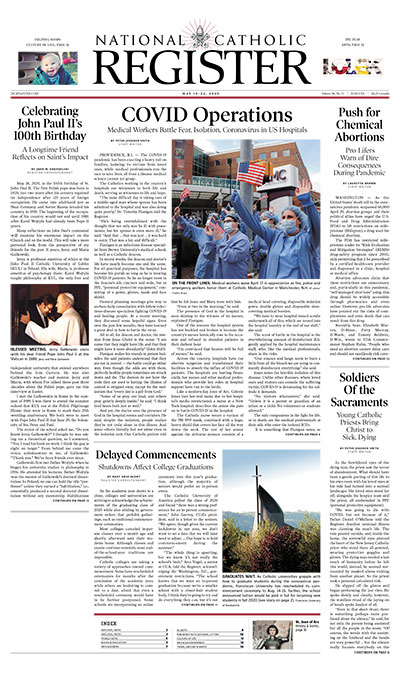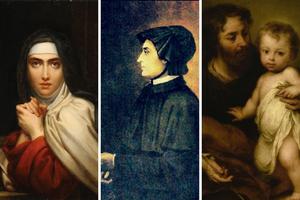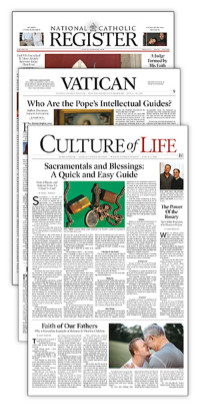Seton Shrine Museum Exhibit Will Examine the ‘Lost Art’ of Needlework
The museum and visitors center, which opens Sept. 22, tells the life story of Mother Seton through an immersive experience, examining her impact as the first native-born American to be canonized.
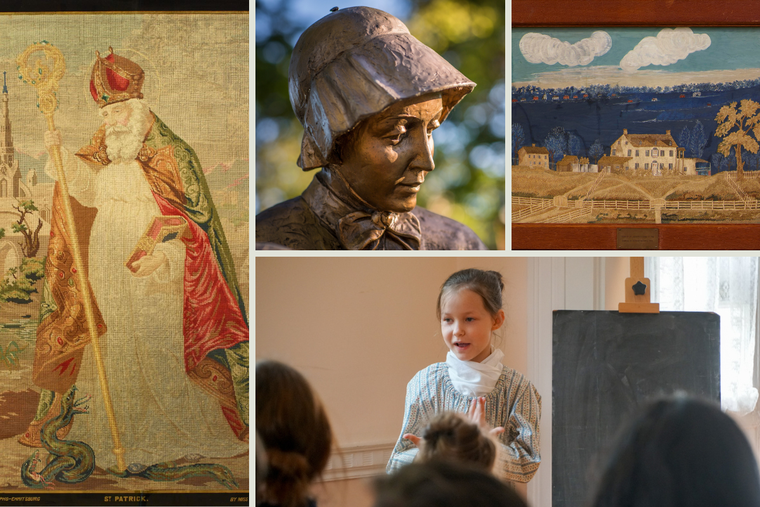
Emmitsburg, Md. — Upon an initial glance, Barbara Motter’s needlework portrait depicts an idyllic scene of rustic, rolling hills and the valley of Emmitsburg, Maryland, providing a snapshot into early-19th-century life. In center frame is the “White House” of St. Joseph’s School — the first free U.S. Catholic school for female education staffed by religious women — of which Motter attended in the mid-1800s.
On a closer examination, among the flowers and other design elements, is a prominently placed white steepled structure — most likely the Emmitsburg Lutheran Church, which is fitting because Motter was a Lutheran attending a Catholic school.
Motter’s work is one of more than 20 pieces — dating from the early 1800s to the 1870s — that will be featured in “Fancywork: Early American Needlework from St. Joseph’s School,” an exhibit at the new $4-million museum at the National Shrine of St. Elizabeth Ann Seton. The museum and visitors center, which opens Sept. 22, tells the life story of Mother Seton through an immersive experience, examining her impact as the first native-born American to be canonized. The museum will feature state-of-the-art exhibits with artifacts, personal writings, digital interactive exhibits and hands-on activities for all ages.
The shrine, which attracts more than 50,000 people a year, is located on the site that Mother Seton started the first congregation of sisters in the U.S. and the first Catholic school for girls. The grounds still include the “White House,” the building in which Mother Seton lived, taught and worshipped, and a basilica that is home to her tomb. The shrine offers activities throughout the year, including its Junior History Interpreters program, in which volunteers — ages 8-16 — play real historical characters of St. Joseph’s School who share “their” lives and interact with guests.
It’s the stories of these girls that the “Fancywork” exhibit aims to tell. For the 19th-century students, needlework was a vital course in the school’s curriculum that revealed a deeper insight into lives of young women in early America.
“Everyone had to bring skills to the family and to their marriage,” said Lisa Donahue, research and exhibitions coordinator at the shrine, which is located on the grounds of the original school in Emmitsburg. “But these girls worked hard — they worked hard on their education, on their needlework, and they were proud of their accomplishments.”
Teaching ‘Survival’ in Early America
The school, which Mother Seton established in 1809, became a pioneer for the American parochial school system, serving as both a boarding and day school for girls of different social classes and levels of education. According to the March 2006 edition of Catholic Education, the school was “rooted in methods to foster faith-based education and character formation to educate girls to lead devout Catholic lives.”
At the time, finding a Catholic education for girls was difficult, Donahue explains; however, she added that “some of the wealthiest families in the country were sending their daughters” to St. Joseph’s School and “they wouldn’t have done that if the education was not strict and good.”
As part of the curriculum, the girls were educated in English, math, science, penmanship, language and religion. For a fee, extra classes were available like the arts and music. Yet the girls also learned basic needlework because it was a necessary survival skill.
“You had to know how to sew [clothes, curtains or linens] if you were going to have any hopes of marriage or running your own home,” Donahue said. “Yes, people married for love — but there was also this very practical side of it, that being ‘we need to be able to survive.’”
Beyond survival, needlework also served to teach the girls hand-eye coordination, patience and knowledge of the Bible in order to showcase their talents to potential suitors for marriage.
“They would have a variety of stitches and would usually do a Bible verse,” Donahue said.
‘It Makes Life Real’
In the modern age of instant gratification, needlework is a “lost art,” Donahue explained. The new exhibit is designed to not only inspire a new generation to pursue creative endeavors, but show St. Joseph’s impact on American history and, more importantly, the students who crossed the school’s threshold.
In one instance, Sister Josephine Collins instructed several girls to do a needlework of the school. The “Fancywork” exhibit has nearly 10 of these on display and none are identical, Donahue noted.
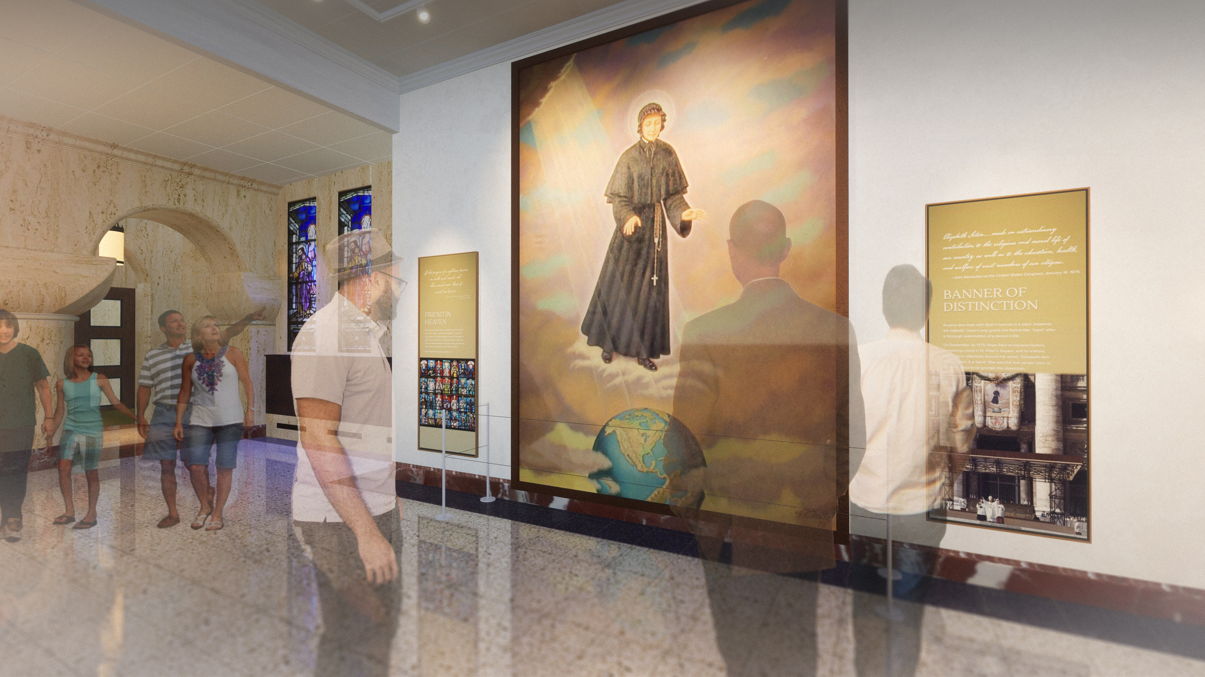
“All of them have added what they saw as important,” she said. “One of them has a sister standing on the porch, and the Barbara Motter piece — since she was not Catholic — had in the background her Lutheran church that was here in town.”
Another significant piece displayed in the exhibit is a tapestry of St. Patrick stitched by 15-year-old Belle Barranger. Started in 1861, Barranger and a religious sister in charge of the tapestry room worked all night to finish the work — that was to be gifted to her father — as the school hastily prepared to dismiss its students due to the American Civil War. She finished “all but the serpent,” according to tradition at the school, and the sister helped her to finish it. Her father loved the art and had it framed. What impresses Donahue about Barranger’s story is her fortitude and determination to finish the work while the Civil War came to the school’s doorstep.
The school was just a few miles away from Gettysburg, where one of the critical battles of the war would be fought in 1863. Sisters from the school worked close to the battlefield, helping to nurse the wounded in makeshift hospitals.
“It puts you in that time and place when [the school] had to close because the soldiers were marching closer and the sisters were being sent out to the battlefields,” Donahue said. “It makes life real.”
While modern sensibilities may see needlework as a relic of a pre-feminist past, Donahue rejects that the stunning works of art are representative of “putting a woman in her place”; rather, they highlight remarkable achievements made by the academy’s young girls.
“People like to manipulate the conversation and make it something not good, and it is good,” she said. “It is good to look at the work that these students did and the hard work that they put into it.”
- Keywords:
- needlework
- st. elizabeth ann seton
- emmitsburg
- crafts
- sewing
